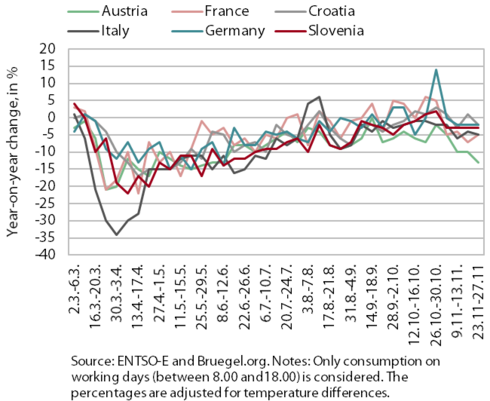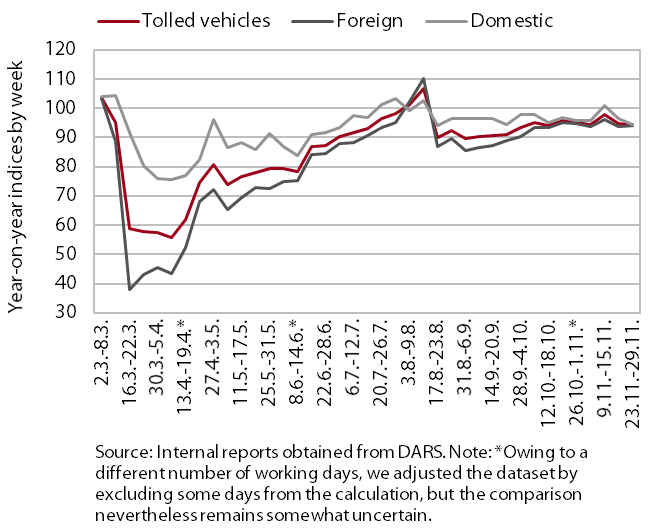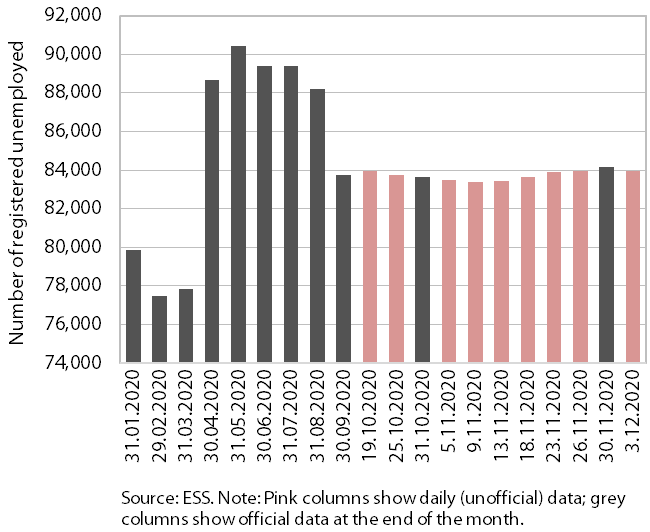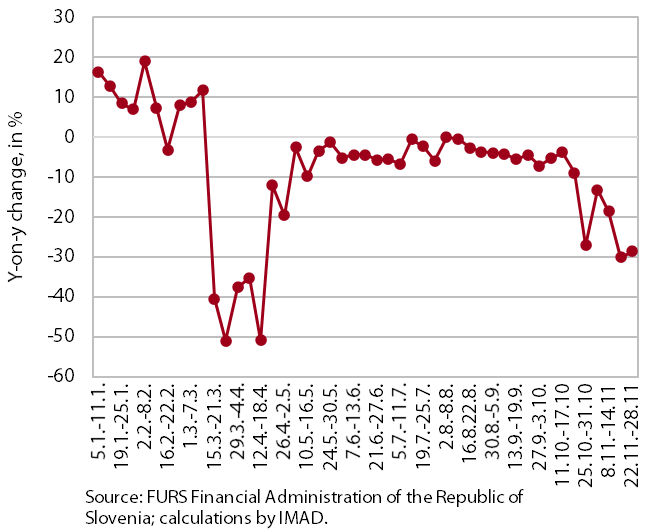Charts of the Week
Current economic trends from 30 November to 4 December 2020: electricity consumption, traffic of electronically tolled vehicles, registered unemployment and fiscal verification of invoices
The indicators of economic activity at the end of November and the beginning of December point to a smaller contraction of economic activity than during the first wave of the epidemic in the spring, when more severe containment measures were immediately implemented. The weekly declines in electricity consumption and freight transport on Slovenian motorways at the end of November were both significantly smaller than during the first wave of the epidemic, which points to greater consequences of the second wave of the epidemic for the service sector. This is also corroborated by a fall in turnover according to data on fiscally verified invoices, which deepened in the second half of November (particularly in trade due to the closure of some non-essential businesses) but remained smaller than in March. Registered unemployment at the beginning of December remained at almost the same level as in the last three months, to a great extent as a consequence of job retention measures and less sever measures and thus a smaller decline in activity.
Electricity consumption, November 2020

With less stringent containment measures than in the first wave of the epidemic, the year-on-year decline in electricity consumption was significantly smaller in the last week of November than in the spring. In the last week of November, electricity consumption was, as in the previous three weeks, 3% lower y-o-y (in April by around 18% lower on average). Among our main trading partners, the decline was largest in Austria (13%). In others, it was smaller, at around 2% in Germany and Croatia and at around 5% in Italy and France.
Traffic of electronically tolled vehicles on Slovenian motorways, November 2020

Freight traffic on Slovenian motorways in the second half of November was somewhat lower than before the epidemic. Having already reached pre-epidemic levels by mid-August, it fell slightly before coming closer to last year’s level again in October. In the week between 23 and 29 November, it lagged 6% behind last year's level in both foreign and domestic hauliers. So far, freight traffic has not been significantly affected by restrictions in the second wave of the epidemic related to trade and accommodation and food service activities. The supply of these activities is more dependent on local than motorway transport. Also, these activities partly operate through online sales and food delivery.
Registered unemployment, December 2020

At the beginning of December, the number of registered unemployed remained at almost the same level as in the previous three months, despite the renewed restrictions on business operations since mid-October. Following the strong growth in the first wave of the epidemic, the number of registered unemployed persons has been gradually falling since mid-year after the adoption of intervention job retention measures and the lifting of restrictions. Since mid-October, when the second wave of the epidemic was declared, the number has remained at a similar level, which, in addition to the partial adaptation of businesses and consumers to different ways of operation, is to a great extent due to the extension of intervention measures and a smaller decline in economic activity than in the first wave. According to ESS unofficial (daily) data, 83,938 persons were unemployed on 3 December, which is very similar to the number at the end of November and around 13% more than in the same period last year.
Fiscal verification of invoices, November 2020

According to data on the fiscal verification of invoices, turnover declined further in the second half of November, but the year-on-year fall was smaller than in the spring. In the second half of November, turnover was around 30% lower than in the same period last year. The decline was thus still smaller than at the end of March (a decline of more than 50%). Similar to the beginning of November, turnover declines remained largest in gambling and betting activities, arts and entertainment activities, travel agencies, and accommodation. The considerably larger total fall than in the first half of November was largely due to the closure of some non-essential shops and services, which opened temporarily between 6 and 15 November 2020.
